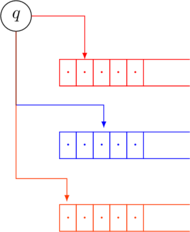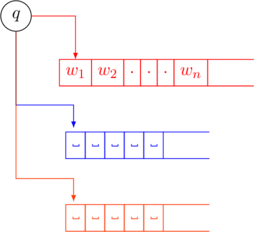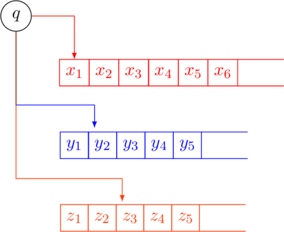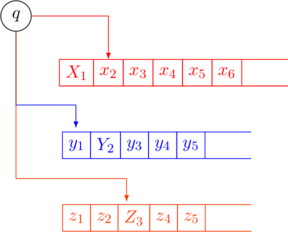A multi-tape Turing Machine (TM) is a TM with access to a fixed finite number of tapes. A ![]() -tape TM has access to
-tape TM has access to ![]() tapes.
tapes.
Initial Configuration
The input string is placed on the first tape. All other tapes are blank. All tape heads point to the start of their respective tapes.
Transition Function
The transition function ![]() is mapped as follows
is mapped as follows
Based on the current state and the current-tape cell read by each of the ![]() tapes, the transition specifies the next state, what to write on each of the
tapes, the transition specifies the next state, what to write on each of the ![]() tapes and the direction to move the tape-head on each of the
tapes and the direction to move the tape-head on each of the ![]() tapes.
tapes.
The direction ![]() implies staying on the current cell.
implies staying on the current cell.
Equivalence to Single Tape
Any multi-tape Turing Machine computation can be carried out by an equivalent single-tape Turing Machine.
The single-tape TM has the tape contents of the individual tapes separated by a separator symbol (![]() ). The tape-head of each individual tape is marked by the dotted equivalent of the symbol it points to.
). The tape-head of each individual tape is marked by the dotted equivalent of the symbol it points to.
To carry out one transition of a ![]() -tape TM on the single-tape
-tape TM on the single-tape
- Scan right to the first dotted symbol. Remember this symbol in the current state.
- Repeat step 1 to scan and remember
 symbols in the current state.
symbols in the current state. - The current state and the
 symbols will have a finite number of possibilities.
symbols will have a finite number of possibilities. - Use the transition function to find the next configuration.
- Bring tape-head back to the start.
- Scan right to the first dotted symbol. Apply the configuration for the first tape. This involves writing a symbol, and moving the tape-head (reapplying the dot). If the dotted symbol is one cell to the left of a separator, a new blank cell must be added to accommodate for a
 transition.
transition. - Repeat step 6 to scan and apply the configuration for each of the
 tapes.
tapes.
Remembering symbols
A Turing Machine can remember by using specific states. Say the tape alphabet is ![]() and there are
and there are ![]() tapes. There can be a state
tapes. There can be a state ![]() to remember that the current state is
to remember that the current state is ![]() , the tape-heads point to
, the tape-heads point to ![]() on the first-tape,
on the first-tape, ![]() on the second-tape and
on the second-tape and ![]() on the third-tape. From this state it can make an appropriate transition by following the transition function.
on the third-tape. From this state it can make an appropriate transition by following the transition function.
Finite number of possibilities
To remember multiple symbols, a single-tape TM equivalent to a ![]() -tape TM (with
-tape TM (with ![]() states) will need
states) will need ![]() new states for each of the
new states for each of the ![]() states for a total of
states for a total of ![]() states.
states.
Adding a new blank cell
Adding a new blank cell involves shifting all the contents of the tape one cell to the right. This has to be done in a right-most first fashion.
Conclusion
A language ![]() is recognized by a single-tape TM if and only if
is recognized by a single-tape TM if and only if ![]() is recognized by a
is recognized by a ![]() -tape TM.
-tape TM.
A language ![]() is decided by a single-tape TM if and only if
is decided by a single-tape TM if and only if ![]() is decided by a
is decided by a ![]() -tape TM.
-tape TM.




